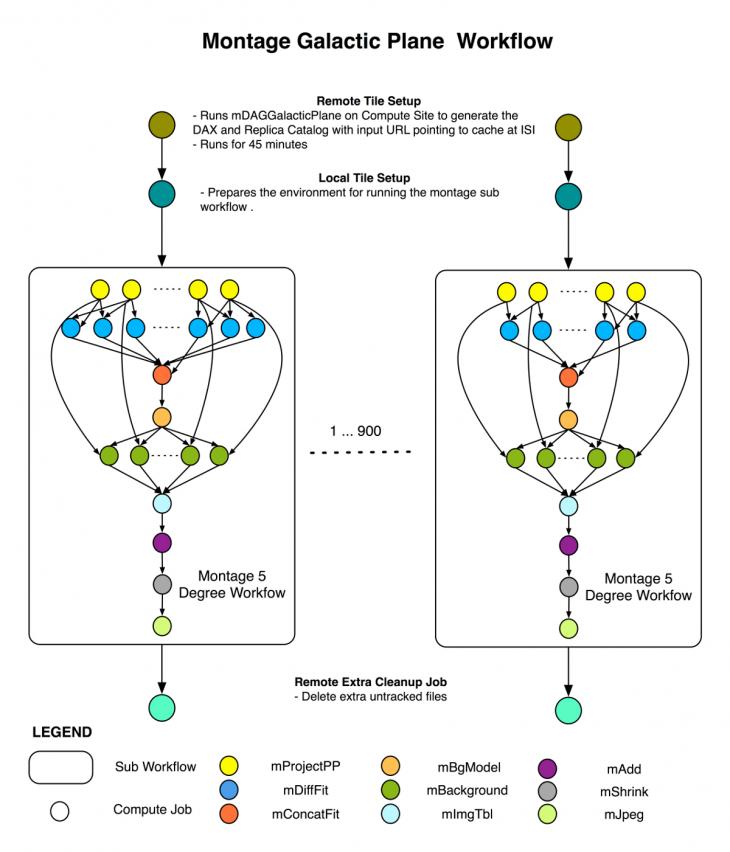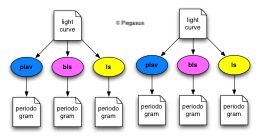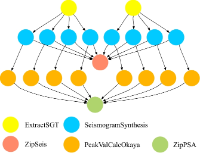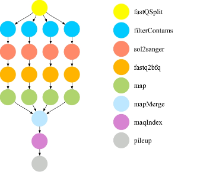Workflow Gallery
Gallery Info
Pegasus is curently being used in a broad range of applications. This gallery categorizes the workflow runs by application.
You can click on an application link to access the archived workflow runs for that Application.
The Application page shows all the runs of that workflow type along with a short summary of the workflow .
The runs shown here are actual runs done through Pegasus using actual data and executables.
| Workflow type | Structure |
|---|---|
|
BrainA RseqFlow workflow which can implement a set of RNA-Seq analysis, such as performing quality control (QC) for sequencing data, generating signal tracks of mapped reads, calculating expression levels, and identifying differentially expressed genes. |

|
|
GalacticThe Galactic Plane workflow will use the Montage image mosaic engine to transform all the images in 17 sky surveys to a common pixel scale of 1 second or arc, where all the pixels are co-registered on the sky and represented in Galactic coordinates and the Cartesian projection. |

|
|
PeriodogramNASA’s Infared Processing and Analysis Center (IPAC) use workflow technologies to process the large amount of data produced by the Kepler mission. IPAC has developed a set of analysis codes to compute periodograms from light curves. These periodograms reveal periodic signals in the light curves that arise from transiting planets and stellar variability. |

|
|
DART
The DART workflows use DART Music Information Retrieval
(MIR) research platform to perform a parameter sweep
experiment in order to discover the optimal parameter
settings for the sub-harmonic summation pitch
detection algorithm.
DART has become a viable platform from which to conduct
MIR experiments and research. The application currently
performs a series of sub-algorithms on a several audio files
(downloaded by the user in the current prototype)
that make up a pitch detection algorithm
(sub-harmonic summation). Ingrained in many MIR processes
is the necessity to determine pitch, which can be
computationally demanding.
|

|
|
SiphtThe SIPHT workflow, from the bioinformatics project at Harvard, is used to automate the search for untranslated RNAs (sRNAs) for bacterial replicons in the NCBI database. |

|
|
Synthetic ScecA Synthetic Workflow that corresponds to a full Cybershake site from 2009 production run. All the jobs are run locally. |

|
|
CyberShakeThe CyberShake workflow is used by the Southern Calfornia Earthquake Center to characterize earthquake hazards in a region. |

|
|
BroadbandBroadband platform enables researchers to combine long period (<1.0Hz) deterministic seismograms with high frequency (~10Hz) stochastic seismograms. |

|
|
EpigenomicsThe epigenomics workflow created by the USC Epigenome Center and the Pegasus Team is used to automate various operations in genome sequence processing. |

|
|
LIGOLIGO workflow is used to generate and analyze gravitational waveforms from data collected during the coalescing of compact binary systems. |

|
|
MontageThe Montage application created by NASA/IPAC stitches together multiple input images to create custom mosaics of the sky. |

|